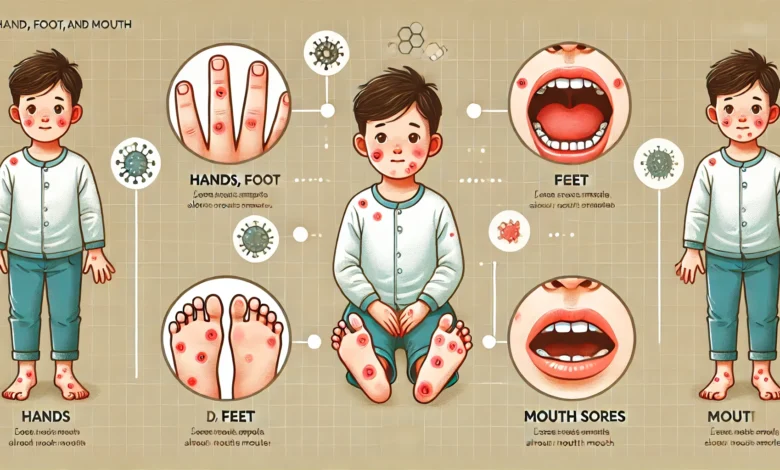Understanding Hand, Foot, and Mouth Disease (HFMD)

What is Hand, Foot, and Mouth Disease?
Hand, Foot, and Mouth Disease (HFMD) is a common viral illness that primarily affects young children but can also occur in adults. It’s characterized by sores in the mouth and a rash on the hands and feet. The disease is caused by various viruses, most commonly the coxsackievirus A16 and enterovirus 71.
HFMD is highly contagious and spreads through close contact, respiratory droplets, and contaminated surfaces. While it might sound alarming, most cases are mild and resolve on their own within a week to ten days. However, understanding the symptoms, transmission, and preventive measures is crucial to managing outbreaks effectively.
Although HFMD is not considered a serious illness, its symptoms can be uncomfortable, especially for young children. Recognizing the early signs can help with timely care and minimize the spread within families and communities.
Symptoms of Hand, Foot, and Mouth Disease
Early Signs of HFMD

The initial symptoms of HFMD often resemble those of a common cold. Fever is usually the first sign, accompanied by fatigue, sore throat, and a reduced appetite. Parents might notice their children becoming irritable or fussy, which can be attributed to general discomfort and a sore throat.
These early signs can make it challenging to distinguish HFMD from other illnesses. However, as the disease progresses, more specific symptoms appear, which make it easier to identify.
Mouth Sores and Rash
One of the hallmark symptoms of HFMD is the development of painful sores in the mouth. These sores, also known as herpangina, typically appear as small red spots or blisters on the tongue, gums, and inside the cheeks. They can make eating and drinking uncomfortable, which might lead to dehydration in young children.
In addition to mouth sores, a rash usually develops on the hands, feet, and sometimes the buttocks or knees. The rash may appear as red spots or blisters and is often not itchy, but it can be tender to the touch. These rashes and sores are a defining characteristic of HFMD and set it apart from other illnesses with similar symptoms.
Causes and Transmission
Viral Causes
HFMD is caused by several types of viruses, most commonly coxsackievirus A16 and enterovirus 71. These viruses belong to the enterovirus family, which is known for causing a variety of illnesses. The specific strain of virus can sometimes influence the severity of the symptoms, with enterovirus 71 being associated with more severe cases.
How It Spreads
The disease spreads primarily through direct contact with an infected person’s saliva, nasal secretions, feces, or blister fluid. It can also spread through contaminated objects or surfaces, making hygiene a critical factor in prevention. Daycares, schools, and other places where children are in close contact are common hotspots for HFMD outbreaks.
Respiratory droplets from coughing or sneezing can also transmit the virus, especially during the first week of illness when the infected person is most contagious. However, the virus can remain in the body for weeks after symptoms subside, meaning that asymptomatic carriers can also contribute to its spread.
Treatment and Home Care
Managing Symptoms
There is no specific cure for HFMD, but the symptoms can be managed to ensure comfort and prevent complications. Over-the-counter pain relievers like acetaminophen or ibuprofen can help reduce fever and alleviate pain from mouth sores. However, aspirin should not be given to children due to the risk of Reye’s syndrome.
Keeping the affected child hydrated is crucial, as dehydration is a common concern due to difficulty swallowing. Offering cold or soft foods, like yogurt, ice cream, or smoothies, can help soothe sore throats and ensure adequate nutrition.
When to See a Doctor
While most cases of HFMD are mild, there are instances where medical attention is necessary. If a child shows signs of severe dehydration, high fever that doesn’t subside, or symptoms of neurological complications like confusion or difficulty walking, it’s important to seek professional care immediately.
Prevention Tips
Hygiene Practices
Good hygiene is the cornerstone of preventing HFMD. Regular handwashing with soap and water, especially after using the restroom or changing diapers, is crucial. Teaching children to cover their mouths and noses when sneezing or coughing can also reduce the spread of respiratory droplets.
Disinfecting frequently touched surfaces and toys can minimize the risk of transmission in shared spaces. Additionally, encouraging children not to share utensils, cups, or personal items can help prevent the spread of the virus.
Avoiding Close Contact
During an outbreak, keeping sick individuals isolated as much as possible can prevent the spread of HFMD. Children with HFMD should stay home from school or daycare until they are no longer contagious, which is usually a week after symptoms begin.
Parents and caregivers should also take precautions, as adults can contract the virus and potentially spread it to others, even if they have mild or no symptoms.
Conclusion
Hand, Foot, and Mouth Disease might be a common illness, but its impact can be minimized with proper awareness and hygiene practices. Understanding the symptoms and how the disease spreads empowers parents, caregivers, and communities to take preventive measures and provide effective care.
While HFMD is usually not serious, it’s important to monitor symptoms closely and consult a healthcare professional when necessary. By prioritizing hygiene and being vigilant about symptoms, we can reduce the spread and ensure a quicker recovery for those affected.



